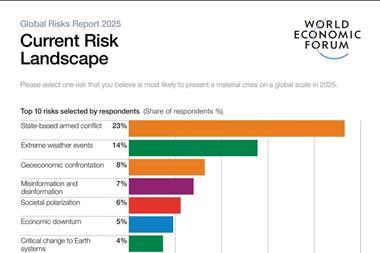In an industry already burdened by a plethora of risks, from passenger safety to environmental concerns and geopolitical crises to fuel costs, the aviation sector has another area of concern – GPS spoofing. Trevor Treharne investigates.
“One of the hot topics that has been emerging over the past few weeks, which affects aircraft operators, OEMs [original equipment manufacturers], aviation authorities and navigation system manufacturers, is GPS spoofing,” says Jay Davies, aviation risk manager at FlightSafe.
“There has been a growing number of cases reported via OpsGroup since the end of August where aircrews have been reporting GPS spoofing events, ranging from fake GPS positioning to more severe cases rendering entire aircraft navigation systems useless, even routing aircraft into dangerous airspace.”

WHAT IS GPS SPOOFING?
GPS spoofing is the deliberate manipulation of Global Positioning System (GPS) signals to deceive navigation systems on aircraft .
This malicious act can result in false positioning information, potentially endangering flght safety.
Spoofing may mislead autopilot systems and air traff ic control, causing incorrect course calculations. As technology advances, safeguarding against GPS spoofing has become increasingly crucial to ensure the integrity of navigation systems.
Aviation authorities and industry stakeholders are continually working to develop robust countermeasures to detect and prevent such spoofing attempts, safeguarding air travel from potential disruptions and enhancing overall aviation security.
“The experiment demonstrated the feasibility of spoofing attacks and emphasised their difficulty in detection”
In the summer of 2013, assistant professor Todd Humphreys of the Department of Aerospace Engineering and Engineering Mechanics at the Cockrell School of Engineering, The University of Texas, led a radio navigation research team.
Their objective was to determine if they could divert a 213-foot yacht off its course using a custom-made GPS device. The team successfully spoofed the $80m private yacht using what was then the world’s first fully fledged GPS spoofing device.
The device utilised false civil GPS signals to gain control of the vessel’s GPS receivers.
At the time, Humphreys underscored that “a great deal of the world’s human transportation [is] going across the skies,” and issued a warning to the aviation industry – the experiment demonstrated the feasibility of spoofing attacks and emphasised their difficulty in detection.
The following aircraft have been impacted so far: Airbus A330; Boeing 737, 747 & 777; Bombardier Challenger 650, Global 7500 & Global Express; Dassault Falcon 2000 & 8X; Embraer 190; and Gulfstream 650.
“There has been little guidance from authorities and manufacturers on how to mitigate these spoofing events”
Davies says: “The concerns are that this may become more widespread, with more spoofing locations appearing elsewhere across the globe. Erroneous locations could cause mid-air collisions. Aircraft may unknowingly track into dangerous airspace, or a sudden loss of navigation systems may cause the ‘startle effect’ - distracting crews from operating the aircraft safely.”
There has been little guidance from authorities and manufacturers on how to mitigate these spoofing events.
As a result, operators are finding their own workarounds, such as disconnecting the GPS from the flight management system and inertial reference system prior to entering known spoofing hotspots and relying on more conventional navigation aids such as non-directional beacons and very high frequency omni-directional range.
Davies says: “It is possible we may start to see a military upgrade to commercial avionics. Honeywell have developed a vision-aided navigation system, which uses optical and infrared cameras to compare the terrain to maps with an accuracy of 10 metres. They have also developed celestial-aided navigation, which uses Star Tracker and has a 30-metre accuracy.”
WHERE HAS GPS SPOOFING OCCURRED?
Davies said currently there are three regional hotspots where these events are being reported:
NORTHERN BAGHDAD FIR, TEHRAN FIR AND BAKU FIR
“There have been multiple reported incidents where aircraft have suffered loss of GPS, emergency power unit, FMS [flight management system] and IRS [inertial reference system] requiring air traffic control to provide the crews with radar vectors for onward flight to their destination,” says Davies.
“One of these occurrences was an Embraer Legacy 650 travelling from Europe to Dubai, which lost GPS and the IRS failed. The autopilot had begun to track left and took them 80 nautical miles off course.
“The aircraft nearly entered Iranian airspace without clearance. It was only a few years back, on 8 January 2020, when Iran accidentally shot down Ukrainian International Airlines Flight 752.”
CAIRO FIR, NICOSIA FIR AND AMMAN FIR
Davies says aircraft in the Cairo FIR have been receiving spoofed GPS events locating them to remain stationary over Tel Aviv/Ben Gurion International Airport, with one signal indicating this static position for 30 minutes.
Others have reported being directed to Lebanon during departures from Tel Aviv and routing them into forbidden areas.
TEL AVIV FIR, NICOSIA FIR AND AMMAN FIR
“Aircraft have been receiving spoofed GPS events locating them incorrectly over Beirut/OLBA, causing tracking issues for aircraft using instrument departures,” says Davies.
“The maximum range reported so far is 250 nautical miles for these spoofed locations, although some events have shut navigation systems down completely for the remainder of the flight, only returning to normal after the aircraft has been shut down and powered back up.”
WHAT SHOULD RISK MANAGERS DO?
It is crucial for risk managers to conduct a thorough vulnerability assessment, identifying critical systems reliant on accurate GPS data.
Understanding the potential impact on operations, especially in industries like aviation and logistics, is essential.
Compliance with relevant regulations and standards, such as those set by aviation authorities, is paramount to ensure adherence to safety protocols.
“GPS spoofing is not just a concern for risk managers directly in the aviation industry”
Risk mitigation strategies should include the adoption of advanced anti-spoofing technologies, employee training on recognising and reporting unusual GPS behaviour, and collaboration with industry peers and government agencies to share information on emerging threats.
GPS spoofing is not just a concern for risk managers directly in the aviation industry. For risk managers in various sectors, these incidents can cause supply chain delays, logistics inefficiencies and compromise critical infrastructure.
Risks include financial transaction vulnerabilities, emergency service coordination challenges, and potential damage to reputation and customer trust.




















No comments yet